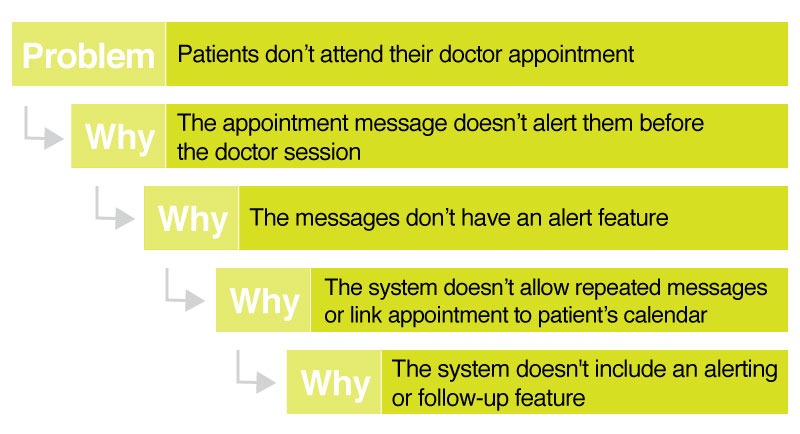What is the 5 Whys Technique?
On this page
- Definition of the 5 Whys Technique
- Origin
- Example
- 6 steps to a successful 5 Whys Analysis
- 5 Benefits of the 5 Whys strategy of problem-solving
- 11 rules to perform the 5 whys technique correctly
Is your team failing to meet deadlines? Or doesn’t produce the expected outcomes? Your organization is dealing with a specific problem?
Use the 5 Whys technique to get to the bottom of it and closer to a solution.
What is the 5 Whys Technique?
The 5 Whys Technique is a simple but great tool you can use to get to the root of a problem. This technique explores the cause-and-effect relationships underlying a particular problem by repeating the question Why? five times. Each question refers to the previous answer.
Origin of the 5 Whys Technique
The technique was originally developed by Sakichi Toyoda, the Japanese industrialist and inventor who started the Toyota family companies. Sakichi used the 5 Whys tool within the Toyota Motor Corporation during the evolution of its manufacturing methodologies.
Example of a 5 Whys Analysis
Let’s say your team has been failing to meet their target for the past five months. Here’s how to apply the 5 whys analysis to your situation:
Problem: Team failed to meet the target for five months in a row
Why?
Two team members were slow to deliver.
Why?
They don’t know how to use the systems.
Why?
When they were hired, they did not receive instructions on how to use them.
Why?
The manager who was in charge of teaching them had to leave the office for a few days to take care of a family situation who required his urgent attention. No other person was assigned to teach them.
Why?
There is no system in place which allows managers to quickly appoint someone else when urgent situations arise.
Now that you have discovered the root cause of the problem, you can easily design a solution to eliminate this problem.
Here is another example of applying the 5 Whys technique:

Source: designorate.com
6 steps to a successful 5 Whys Analysis
- State the specific problem that needs to be addressed.
- Gather your team in one room.
- Use a whiteboard.
- Write the specific problem on the whiteboard.
- Ask the first why and invite team members to provide relevant and specific answers.
- Repeat the whys until the root cause of the problem is identified.
- Develop an action plan to remove the problem from the system.
- Break the action plan into tasks which you assign to each team member.
5 Benefits of the 5 Whys strategy of problem-solving
![]() Identify the cause, not just the symptoms.
Identify the cause, not just the symptoms.
![]() Perform an evidence-based analysis.
Perform an evidence-based analysis.
![]() Eliminate issues in your system for good.
Eliminate issues in your system for good.
![]() Seek improvements and welcome change.
Seek improvements and welcome change.
![]() Build a culture that embraces progress.
Build a culture that embraces progress.
11 rules to perform the 5 whys technique correctly
- Define the problem as accurately and completely as possible.
- Require from your team members complete honesty in answering the questions.
- Be determined to get to the bottom of the problem and resolve it.
- Don’t stop at symptoms, go beyond them.
- Ask the right questions.
- Support your team into being honest.
- Be open to hearing answers that you might not like.
- Five is just the rule of thumb, continue to ask questions until you get to the root cause.
- Ensure that all answers are based on facts and knowledge.
- Assess the process, not people.
- How do you know when you have found the root cause? When eliminating it, you will have prevented the error from occurring again.
Are you going to use the 5 Whys technique?
Join the Conversation
We’d love to hear what you have to say.
Get in touch with us on our LinkedIn Group, Facebook Group or Twitter.